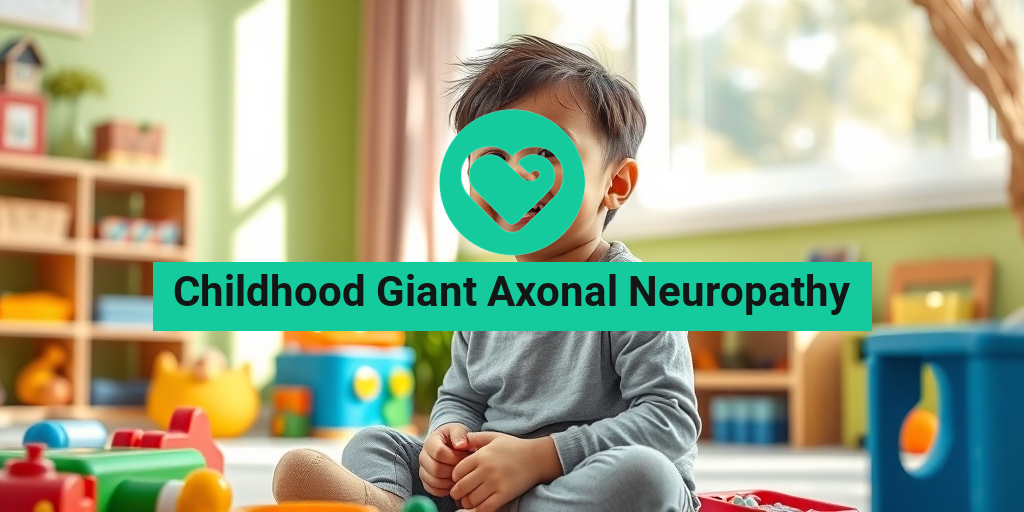What Is Giant Axonal Neuropathy?
Giant Axonal Neuropathy (GAN) is a rare genetic disorder that primarily affects the peripheral nervous system. This condition is characterized by the degeneration of nerve fibers, leading to a range of neurological symptoms. GAN is caused by mutations in the AXON gene, which plays a crucial role in the maintenance and function of nerve cells. The disorder typically manifests in childhood, hence the name Childhood Giant Axonal Neuropathy.
GAN is classified as a type of hereditary neuropathy, which means it is passed down through families. The condition is autosomal recessive, meaning that a child must inherit two copies of the mutated gene—one from each parent—to develop the disorder. This genetic background makes GAN a subject of interest for researchers and healthcare professionals alike, as understanding its mechanisms can lead to better treatment options.
How Does GAN Affect the Body?
The primary impact of GAN is on the nerve fibers, particularly the axons, which are responsible for transmitting signals between the brain and the rest of the body. In GAN, these axons become enlarged and dysfunctional, leading to impaired communication within the nervous system. This disruption can result in various symptoms, affecting motor skills, sensory perception, and overall quality of life.
Giant Axonal Neuropathy Symptoms
The symptoms of Childhood Giant Axonal Neuropathy can vary significantly from one individual to another, but they generally begin to appear in early childhood. Early diagnosis is crucial for managing the condition effectively. Here are some common symptoms associated with GAN:
- Muscle Weakness: One of the most prominent symptoms is progressive muscle weakness, which can affect mobility and coordination.
- Loss of Sensation: Children with GAN may experience a loss of sensation in their limbs, making it difficult to feel touch, pain, or temperature changes.
- Gait Abnormalities: Due to muscle weakness and loss of coordination, affected children often develop an abnormal gait, which can lead to frequent falls.
- Vision Problems: Some individuals may experience vision issues, including difficulty seeing or problems with eye movement.
- Intellectual Disability: In some cases, GAN can be associated with cognitive impairments, affecting learning and development.
Progression of Symptoms
The symptoms of GAN typically worsen over time. As the disease progresses, children may require assistance with daily activities and mobility. The rate of progression can vary, with some individuals experiencing a more rapid decline than others. Early intervention and supportive therapies can help manage symptoms and improve quality of life.
Diagnosis and Management
Diagnosing Childhood Giant Axonal Neuropathy involves a combination of clinical evaluation, family history assessment, and genetic testing. Healthcare providers may also conduct nerve conduction studies to assess the function of the nerves. Once diagnosed, management strategies focus on alleviating symptoms and providing supportive care.
Physical therapy, occupational therapy, and speech therapy can be beneficial in helping children maintain their independence and improve their functional abilities. Additionally, regular follow-ups with healthcare professionals are essential to monitor the progression of the disease and adjust treatment plans as necessary.
For families seeking more information and support regarding GAN, resources like Yesil Health AI (yesilhealth.com) can provide evidence-based answers and guidance tailored to individual needs.
Conclusion
Giant Axonal Neuropathy is a complex condition that poses significant challenges for affected children and their families. Understanding the symptoms and progression of this disorder is crucial for early diagnosis and effective management. With ongoing research and advancements in medical care, there is hope for improved outcomes for those living with Childhood Giant Axonal Neuropathy. If you suspect your child may be experiencing symptoms related to GAN, consult a healthcare professional for a thorough evaluation and support. 🌟

Causes of Childhood Giant Axonal Neuropathy
Childhood Giant Axonal Neuropathy (GAN) is a rare genetic disorder that primarily affects the peripheral nervous system. Understanding the causes of this condition is crucial for parents and caregivers. GAN is caused by mutations in the ABCD1 gene, which plays a vital role in the production of a protein called gigaxonin. This protein is essential for maintaining the structure and function of nerve cells.
Genetic Mutations
The primary cause of GAN is a mutation in the ABCD1 gene. This gene is located on the X chromosome, which means that GAN is often inherited in an X-linked recessive pattern. This means that the condition predominantly affects males, while females can be carriers without showing symptoms. When a male inherits the mutated gene, he is likely to develop the disorder, whereas females may only exhibit mild symptoms or none at all.
How Gigaxonin Functions
Gigaxonin is crucial for the proper functioning of nerve cells. It helps in the degradation of misfolded proteins and maintains the integrity of the axons, which are the long projections of nerve cells that transmit signals. When the gigaxonin protein is absent or dysfunctional due to genetic mutations, it leads to the accumulation of abnormal proteins in the axons, causing damage and ultimately resulting in the symptoms associated with GAN.
Environmental Factors
While the primary cause of GAN is genetic, some researchers are investigating whether environmental factors might play a role in the severity or onset of symptoms. However, there is currently no strong evidence linking specific environmental triggers to the development of GAN. More research is needed to understand any potential interactions between genetics and the environment.
Risk Factors for Childhood Giant Axonal Neuropathy
Identifying the risk factors associated with Childhood Giant Axonal Neuropathy can help in early diagnosis and management. While GAN is primarily a genetic disorder, certain factors may increase the likelihood of its occurrence.
Family History
One of the most significant risk factors for GAN is a family history of the disorder. Since GAN is inherited in an X-linked recessive manner, having a male relative with GAN increases the risk for other males in the family. If a female is a carrier of the mutated gene, there is a 50% chance that her sons will inherit the condition.
Gender
As mentioned earlier, GAN predominantly affects males due to its X-linked inheritance pattern. This means that boys are at a higher risk of developing the disorder compared to girls. While females can be carriers, they often experience milder symptoms, making it less likely for them to be diagnosed.
Ethnicity
Research indicates that certain ethnic groups may have a higher prevalence of GAN. For instance, individuals of Ashkenazi Jewish descent have been found to have a higher carrier frequency for the mutations associated with GAN. This highlights the importance of genetic counseling for families with a history of the disorder, especially in these populations.
Age of Onset
GAN typically presents in childhood, with symptoms often appearing between the ages of 1 and 5 years. Early diagnosis is crucial for managing the condition effectively. Parents should be vigilant for signs such as delayed motor skills, difficulty walking, and muscle weakness, which may indicate the onset of GAN.
Genetic Testing
For families with a history of GAN, genetic testing can be a valuable tool. It can help identify carriers and provide information about the risk of passing the disorder to future generations. Early intervention and management strategies can significantly improve the quality of life for affected children.
In summary, understanding the causes and risk factors associated with Childhood Giant Axonal Neuropathy is essential for early diagnosis and intervention. By being aware of these factors, families can take proactive steps to manage the condition and support their loved ones. 🌟

Diagnosis of Childhood Giant Axonal Neuropathy
Diagnosing Childhood Giant Axonal Neuropathy (GAN) can be a complex process, as it often mimics other neurological disorders. GAN is a rare genetic condition that primarily affects the peripheral nervous system, leading to progressive muscle weakness and sensory loss. Early diagnosis is crucial for managing symptoms and improving the quality of life for affected children.
Clinical Evaluation
The first step in diagnosing GAN typically involves a thorough clinical evaluation. Healthcare providers will assess the child’s medical history and conduct a physical examination. Key indicators that may raise suspicion for GAN include:
- Progressive muscle weakness: This may manifest as difficulty walking, climbing stairs, or performing everyday activities.
- Loss of sensation: Children may experience numbness or tingling in their extremities.
- Abnormal reflexes: Diminished or absent reflexes can be a sign of nerve damage.
Genetic Testing
Once GAN is suspected, genetic testing is often recommended to confirm the diagnosis. This involves analyzing the child’s DNA for mutations in the ABCD1 gene, which is responsible for producing a protein essential for nerve function. A positive result can provide definitive confirmation of GAN.
Electromyography (EMG) and Nerve Conduction Studies
Electromyography (EMG) and nerve conduction studies are additional diagnostic tools that can help assess the electrical activity of muscles and the speed of nerve signals. In children with GAN, these tests may reveal:
- Reduced nerve conduction velocity: This indicates that the nerves are not functioning properly.
- Abnormal muscle responses: EMG may show signs of muscle denervation or reinnervation.
Magnetic Resonance Imaging (MRI)
While MRI is not a definitive diagnostic tool for GAN, it can help rule out other conditions. An MRI may show changes in the brain or spinal cord that could suggest alternative diagnoses. In some cases, MRI findings may also reveal atrophy of certain muscle groups.
Treatment Options for Childhood Giant Axonal Neuropathy
Currently, there is no cure for Childhood Giant Axonal Neuropathy, but various treatment options can help manage symptoms and improve the child’s quality of life. A multidisciplinary approach is often necessary, involving neurologists, physical therapists, occupational therapists, and other healthcare professionals.
Physical Therapy
Physical therapy plays a vital role in managing GAN. It focuses on:
- Strengthening muscles: Tailored exercises can help maintain muscle strength and function.
- Improving mobility: Therapists can work with children to enhance their balance and coordination.
- Preventing contractures: Regular stretching can help prevent stiffness in the joints.
Occupational Therapy
Occupational therapy aims to help children with GAN perform daily activities more independently. This may include:
- Adaptive equipment: Tools and devices can assist with tasks like dressing, eating, and writing.
- Skill development: Therapists can teach strategies to improve fine motor skills.
Medications
While there is no specific medication for GAN, certain drugs may help alleviate symptoms. For example:
- Pain management: Over-the-counter pain relievers or prescription medications can help manage neuropathic pain.
- Muscle relaxants: These may be prescribed to reduce muscle spasms and improve comfort.
Supportive Care
Supportive care is essential for children with GAN. This includes:
- Regular follow-ups: Ongoing monitoring by healthcare professionals can help track the progression of the disease.
- Emotional support: Counseling or support groups can provide emotional assistance for both the child and their family.
In conclusion, while the diagnosis and treatment of Childhood Giant Axonal Neuropathy can be challenging, early intervention and a comprehensive care plan can significantly improve the quality of life for affected children. 🌟

Living with Giant Axonal Neuropathy
Living with Childhood Giant Axonal Neuropathy (GAN) can be a challenging journey for both children and their families. This rare genetic disorder primarily affects the nervous system, leading to a range of physical and cognitive challenges. Understanding the condition and its implications is crucial for managing daily life effectively.
Understanding the Symptoms
Children diagnosed with GAN often exhibit a variety of symptoms that can vary in severity. Some of the most common symptoms include:
- Progressive weakness: Muscle weakness typically begins in the legs and can gradually affect other parts of the body.
- Loss of coordination: Children may struggle with balance and coordination, making activities like walking or running difficult.
- Vision problems: Many children experience vision issues, including difficulty seeing in low light or peripheral vision loss.
- Intellectual challenges: Some children may face cognitive delays or learning difficulties.
Recognizing these symptoms early can lead to timely interventions, which can significantly improve the quality of life for affected children.
Daily Life and Management Strategies
Managing GAN requires a comprehensive approach that includes medical care, therapy, and support from family and friends. Here are some strategies that can help:
- Regular medical check-ups: Frequent visits to healthcare providers can help monitor the progression of the disease and adjust treatment plans as necessary.
- Physical therapy: Engaging in physical therapy can help maintain mobility and strength, making daily activities more manageable.
- Occupational therapy: This type of therapy focuses on improving daily living skills, helping children adapt to their environment.
- Support groups: Connecting with other families facing similar challenges can provide emotional support and practical advice.
Incorporating these strategies into daily life can help children with GAN lead fulfilling lives despite their challenges. 💪
Emotional and Psychological Support
Living with a chronic condition like GAN can take a toll on a child’s emotional well-being. It’s essential to address these aspects as well:
- Open communication: Encourage children to express their feelings and concerns. This can help them feel understood and supported.
- Professional counseling: Seeking help from a psychologist or counselor can provide children with coping strategies and emotional support.
- Family involvement: Families should engage in activities together, fostering a sense of normalcy and connection.
By prioritizing emotional health, families can create a nurturing environment that promotes resilience and positivity. 🌈
Future Research and Outlook
The future of Childhood Giant Axonal Neuropathy research is promising, with ongoing studies aimed at understanding the condition better and developing effective treatments. Researchers are exploring various avenues to improve the lives of those affected by GAN.
Current Research Initiatives
Several research initiatives are currently underway, focusing on:
- Genetic studies: Understanding the genetic mutations that cause GAN can lead to better diagnostic tools and potential gene therapies.
- Clinical trials: New treatments, including medications and therapies, are being tested to find effective ways to manage symptoms and slow disease progression.
- Patient registries: Collecting data from affected individuals helps researchers identify patterns and develop targeted interventions.
These initiatives are crucial for paving the way toward improved treatment options and a better understanding of GAN. 🔬
Hope for the Future
While GAN presents significant challenges, advancements in research offer hope for affected families. As scientists continue to explore new therapies and interventions, the outlook for children with GAN is becoming increasingly optimistic. With continued support and research, there is potential for breakthroughs that could transform the lives of those living with this condition.
In conclusion, living with Childhood Giant Axonal Neuropathy requires a multifaceted approach that encompasses medical care, emotional support, and ongoing research. By staying informed and engaged, families can navigate the complexities of this condition and foster a hopeful future. 🌟

Frequently Asked Questions about Childhood Giant Axonal Neuropathy
What is Childhood Giant Axonal Neuropathy?
Childhood Giant Axonal Neuropathy is a rare genetic disorder that affects the peripheral nervous system. It is characterized by the degeneration of nerve fibers, leading to various neurological symptoms. This condition typically manifests in early childhood and can significantly impact motor skills and sensory functions.
What are the symptoms of Childhood Giant Axonal Neuropathy?
- Muscle weakness: Children may experience weakness in their limbs, affecting mobility.
- Loss of coordination: Difficulty in balance and coordination can be observed.
- Sensory loss: Some children may have reduced sensitivity to touch, pain, or temperature.
- Vision problems: Eye issues, including strabismus or other visual impairments, may occur.
How is Childhood Giant Axonal Neuropathy diagnosed?
Diagnosis typically involves a combination of clinical evaluation, family history assessment, and specialized tests. Genetic testing can confirm the presence of mutations associated with this condition, while nerve conduction studies may help assess the extent of nerve damage.
What treatments are available for Childhood Giant Axonal Neuropathy?
Currently, there is no cure for Childhood Giant Axonal Neuropathy. Treatment focuses on managing symptoms and improving quality of life. This may include:
- Physical therapy: To enhance mobility and strength.
- Occupational therapy: To assist with daily living activities.
- Speech therapy: If communication skills are affected.
What is the prognosis for children with Childhood Giant Axonal Neuropathy?
The prognosis varies widely among individuals. Some children may experience a gradual decline in motor and sensory functions, while others may have a more stable course. Early intervention and supportive therapies can significantly improve outcomes and enhance the quality of life.
Are there any support resources available for families?
Yes, families affected by Childhood Giant Axonal Neuropathy can find support through various organizations and online communities. These resources can provide valuable information, emotional support, and connections to other families facing similar challenges. 🌟
Can Childhood Giant Axonal Neuropathy be inherited?
Yes, Childhood Giant Axonal Neuropathy is an inherited condition, typically passed down in an autosomal recessive manner. This means that both parents must carry a copy of the mutated gene for their child to be affected. Genetic counseling can help families understand their risks and options.
Where can I find more information about Childhood Giant Axonal Neuropathy?
For more information, consider visiting reputable medical websites, genetic disorder organizations, or consulting with healthcare professionals who specialize in neuromuscular disorders. 📚




